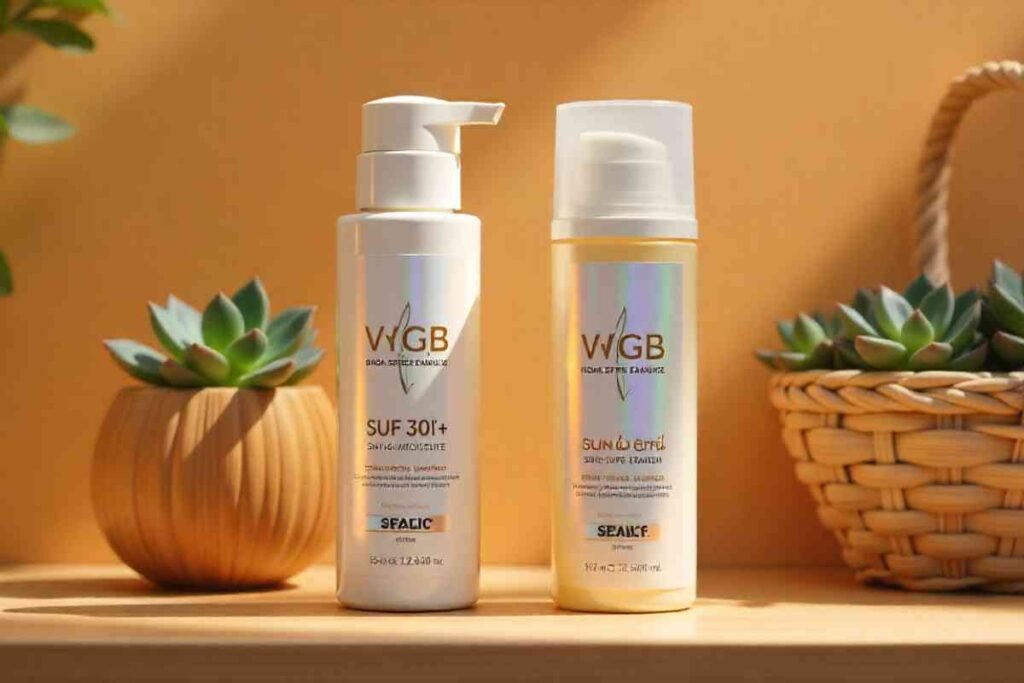Sunscreen or moisturizer first is a common skincare question.Many people get confused about which one to apply first.The right order ensures your skin stays healthy and protected.
This guide explains whether sunscreen or moisturizer should come first. It covers expert advice scientific reasoning and dermatologist tips.By knowing the correct step you can maximize product benefits.
If you want glowing youthful and damage free skin every day keep reading.Our complete guide will help you avoid mistakes in your daily routine.Discover the secret to balanced skincare that keeps you confident and safe.
Why the Order of Skincare Products Matters?

Sunscreen or moisturizer first routines are not just about what you apply but also how and when you apply them. Each product is formulated to serve a specific purpose and its effectiveness depends on whether it is applied in the correct sequence.
When we ask sunscreen or moisturizer first the answer lies in understanding how these products interact with the skin.
Moisturizers hydrate and nourish the skin while sunscreens protect it from harmful UV rays. If applied in the wrong order the moisturizer might block the sunscreen’s protective shield or the sunscreen might prevent the moisturizer from hydrating effectively. Proper layering ensures both benefits are maximized.
Understanding Moisturizer in Skincare
Moisturizer is an essential step in Sunscreen or moisturizer first because it helps keep your skin soft smooth and hydrated.It works by locking in moisture and creating a protective barrier against dryness and environmental damage.
Using a moisturizer regularly can prevent dullness flakiness and early signs of aging.No matter your skin type choosing the right moisturizer ensures healthy glowing and balanced skin.
What is a Moisturizer?
A moisturizer is a skincare product designed to hydrate the skin by preventing water loss. It creates a protective barrier that locks in moisture making the skin soft supple and less prone to dryness. Depending on your skin type moisturizers can be lightweight gel based or rich creams.
Benefits of Moisturizer
Moisturizer keeps your skin hydrated improves elasticity and helps combat issues like flakiness irritation or fine lines.
For those with specific concerns such as acne aging or uneven texture moisturizers often include additional ingredients like hyaluronic acid retinol or ceramides.
Why Moisturizer is Applied First?
When considering sunscreen or moisturizer first dermatologists recommend moisturizer first because it needs to be absorbed into the skin.
Sunscreen or moisturizer first first would create a barrier that prevents moisturizer from penetrating effectively reducing its hydration benefits.
Understanding Sunscreen in Skincare
Sunscreen is a vital part of skincare that helps protect your skin from harmful UV rays preventing sunburn and early aging. Using it daily keeps your skin healthy youthful and safe from long term sun damage.
What is Sunscreen?
Sunscreen is a product formulated to protect the skin from ultraviolet UV radiation. There are two main types:
- Chemical sunscreen: which absorbs UV rays before they can damage the skin.
- Mineral sunscreen: which reflects UV rays like a shield on the skin’s surface.
Why Sunscreen is Essential?
Without Sunscreen or moisturizer first your skin is vulnerable to sunburn premature aging hyperpigmentation and skin cancer. Even on cloudy days or indoors UV rays can penetrate and cause long term harm. That is why sunscreen is the single most important daytime skincare product.
Why Sunscreen is Applied After Moisturizer?
The debate of sunscreen or moisturizer first is resolved by science sunscreen must always go on top. It acts as a protective layer and should not be diluted or disrupted by other products. Moisturizer creates the base and sunscreen seals and shields.
Step by Step Guide: How to Apply Moisturizer and Sunscreen?
Applying moisturizer and sunscreen in the right order ensures your skin stays hydrated and fully protected from harmful UV rays. This step by step guide will help you layer them correctly for maximum skincare benefits.
Step 1: Cleanse Your Skin
Start with a gentle cleanser suited to your skin type. Cleansing removes dirt excess oil and impurities that can interfere with product absorption.
Step 2: Apply Moisturizer
After cleansing apply a moisturizer evenly across your face and neck. Massage it gently and allow it to absorb for about two to three minutes before moving on.
Step 3: Apply Sunscreen
Once the moisturizer has absorbed apply sunscreen as the final step. Use a broad spectrum formula with SPF 30 or higher. Ensure you cover all exposed areas including your ears neck and hands.
Step 4: Reapply Sunscreen
Sunscreen effectiveness reduces over time especially with sweat water or sun exposure. Reapply every two hours for continuous protection.
The Science Behind Sunscreen and Moisturizer Layering
The science behind sunscreen and moisturizer layering explains how each product works to protect and nourish your skin. Understanding their order helps maximize hydration while ensuring full UV protection for healthier skin.
Interaction Between Moisturizer and Sunscreen
The molecular structure of moisturizers allows them to absorb into the skin while sunscreens are designed to sit on top as a shield. If you reverse the order you compromise the sunscreen’s ability to protect.
Expert Recommendations
The American Academy of Dermatology and leading dermatologists worldwide emphasize sunscreen last in your daytime skincare routine. This ensures full UV protection without interference.
Can You Use Moisturizer with SPF Instead of Sunscreen?
Some moisturizers come with built in SPF. While they offer convenience dermatologists caution that they may not provide the same level of protection as a standalone sunscreen.
Most people do not apply enough moisturizer to achieve the labeled SPF. For reliable protection a dedicated sunscreen is recommended.
Should You Mix Sunscreen and Moisturizer?
Mixing the two might seem like a shortcut but it dilutes sunscreen and reduces its effectiveness. Sunscreen formulations are carefully balanced to provide protection and blending disrupts their stability. It is better to layer them properly than to combine.
Sunscreen or Moisturizer First for Different Skin Types
For different skin types the choice of applying sunscreen or moisturizer first depends on your skin’s needs. Knowing the right order helps keep your skin protected hydrated and healthy all day.
For Oily Skin
Choose a lightweight oil free moisturizer that absorbs quickly. Follow with a mattifying sunscreen to avoid greasiness.
For Dry Skin
Use a hydrating moisturizer rich in ceramides or hyaluronic acid. Apply a moisturizing sunscreen for extra nourishment.
For Combination Skin
Apply moisturizer to drier areas followed by sunscreen evenly across the face.
For Sensitive Skin
Opt for a gentle moisturizer and a mineral sunscreen with zinc oxide or titanium dioxide to minimize irritation.
Sunscreen or Moisturizer First with Makeup
If you wear Sunscreen or moisturizer first should always be applied before foundation or concealer. Wait a few minutes after applying sunscreen to let it settle then proceed with makeup. This ensures the sunscreen forms a stable layer without interference.
Morning vs. Night Routine
During the day, your sequence should always be cleanser moisturizer sunscreen and then makeup if desired. At night you can skip sunscreen and focus on cleanser moisturizer and targeted treatments.
Choosing the Right Products

When debating sunscreen or moisturizer first product quality also matters. Look for moisturizers suited to your skin type and sunscreens that are broad spectrum water resistant and SPF 30 or higher.
Expert Tips for Long Term Skin Health
Consistency is more important than complexity. Always cleanse moisturize and apply sunscreen daily. Reapply sunscreen throughout the day and adjust your moisturizer seasonally based on skin needs.
Just like understanding buttermilk benefits supports overall health from within knowing whether sunscreen or moisturizer goes first helps protect and nourish your skin from the outside.
Conclusion
In the debate of sunscreen or moisturizer first the answer is clear moisturizer sets the base while sunscreen locks in complete protection.
Applying them in the right order ensures your skin stays hydrated shielded and healthy throughout the day.Consistency with this simple routine prevents premature aging sun damage and dryness in the long run.
By following expert advice and layering wisely, you can enjoy glowing youthful and confident skin every single day.
FAQs
What goes first, sunscreen or moisturizer?
Moisturizer should be applied first to hydrate and prepare the skin, followed by sunscreen on top to protect from UV damage.
Why is it important to apply sunscreen after moisturizer?
Sunscreen forms a protective shield on the skin’s surface. If applied first, moisturizer can weaken its effectiveness.
Can I use a moisturizer with SPF instead of sunscreen?
Moisturizers with SPF provide some protection but usually not enough. Dermatologists recommend a dedicated sunscreen for full coverage.
Is it okay to mix sunscreen and moisturizer together?
No, mixing reduces sunscreen’s stability and protection. It’s best to apply them separately in the correct order.
Should sunscreen go under or over makeup?
Sunscreen should always go under makeup. Let it absorb for a few minutes before applying foundation or concealer.
Do I need sunscreen if I stay indoors?
Yes, UV rays can still penetrate windows and cause damage, so daily sunscreen use is essential even indoors.
Which sunscreen is best for sensitive skin?
Mineral sunscreens with zinc oxide or titanium dioxide are gentle and less likely to cause irritation for sensitive skin.
How often should I reapply sunscreen?
Sunscreen should be reapplied every two hours, or more frequently if you’re sweating, swimming, or outdoors for long periods.